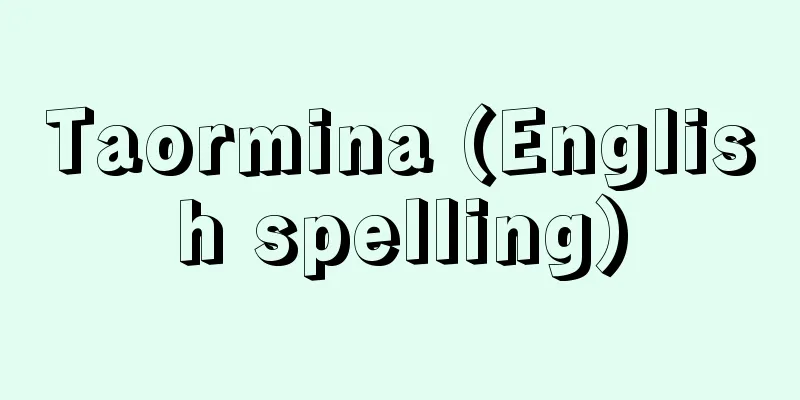Child Psychology

|
A field of psychology that studies the mentality of children. However, the scope of childhood here is broader than common sense, and includes the period from immediately after birth to about elementary school age, that is, from infancy to school age. Currently, it is generally considered a subfield of developmental psychology, but historically it has developed as a separate and unique field. Traditionally, in the Western world, children were often seen as "little adults," and childhood was not given special importance. However, from the 18th to the 19th century, Rousseau, Pestalozzi, Froebel, and others emphasized the mentality of children, which is different from that of adults, and childhood finally began to attract attention. The "century of the child," as Ellen Key called it, was long awaited. In response to this momentum, at the end of the 19th century, W. Preyer (1842-1897) of Germany published a record of observations of his children for the first three years of their lives, and in the United States, Stanley Hall used a questionnaire method to clarify the consciousness of elementary school children, both of which had a great influence. In particular, Hall, influenced by the theory of evolution, established the theoretical foundation of child psychology based on the theory of recurrent development, which states that "ontogeny repeats phylogeny," and established its academic foundation. On the other hand, he called for a child studies movement aimed at the scientific study of children around the world, and this movement spread to Europe as well. Some of his disciples also advocated the creation of child studies. Thus, early child psychology placed more emphasis on children than on psychology. From a broader perspective, it can be said to have been a branch of the humanist movement since Rousseau, which recognized the uniqueness of children and defended their rights based on that recognition. Therefore, it has been considered a very unique field historically, and there was a strong tendency to provide a scientific foundation for practical areas such as child education and clinical practice, rather than theoretical research. On the other hand, as interest in developmental research throughout the lifespan has increased since the 1960s, questions have arisen about treating childhood in isolation, and the view that childhood is one developmental period throughout the lifespan and that child psychology is one subfield within developmental psychology as a whole has become stronger. As a result, the view that child psychology is a unique and separate field has faded, and the name itself has gradually become less used in academic circles. However, it still retains vitality because it has the great advantage of being generally easy to understand. The methods and research goals of child psychology have been absorbed into those of developmental psychology. However, the fact that today's developmental psychology research is often intended to be applied to education, discipline, mental health, etc. shows that the tradition of child psychology since Pryor and Hall is still alive. [Tamotsu Fujinaga] "Child Psychology" by Massen, translated by Imada Megumi (1966, Iwanami Shoten) " ▽ "Child Psychology" edited by Fujinaga Tamotsu (1973, Yuhikaku)" ▽ "Piaget's Clinical Child Psychology, vols. 1-3, by Jean Piaget, translated by Otomo Shigeru (1977, Dobun Shoin)" ▽ "How Do Children See the World? - Behavior and its Meaning" by Tsumori Makoto (1987, NHK Publishing)" ▽ "Outline of Child Psychology" edited by Hata Kazushi and Hirai Seiya (1988, Kitaoji Shobo)" ▽ "Introduction to Child Psychology" by Murata Koji, 3rd edition (1990, Baifukan)" ▽ "New Lectures on Child Psychology" vols. 1-17, edited by Murai Junichi et al. (1990-1993, Kaneko Shobo)" ▽ "Child Psychology" by Okamoto Natsuki (1991, Iwanami Shoten)" ▽ "Hatano Kanji, The Complete Works of Hatano Kanji, Volume 6: Child Psychology (1991, Shogakukan)" ▽ "Uchisuka Ko, Clinical Child Psychology, Revised Edition (1991, Kyodo Publishing)" ▽ "Fujinaga Tamotsu, ed., Modern Developmental Psychology (1992, Yuhikaku)" ▽ "Ohinata Tatsuko et al., Developmental Psychology (1992, Asakura Shoten)" ▽ "Hatano Kanji, ed., Piaget's Developmental Psychology (1993, Kokudosha)" ▽ "Hatano Kanji, Piaget's Child Psychology (1996, Kokudosha)" ▽ "Nomoto Miyoshi, Postwar History of the View of Childhood (1999, Gendaishokan)" ▽ "Jean Piaget, Psychology of Thinking: Six Studies in Developmental Psychology, translated by Takizawa Takehisa (1999, Misuzu Shobo)" ▽ "Child Development and the Environment" by Tsukada Koichi (2000, Meisei University Press)" ▽ "Textbook Series 2 for Teacher Training: Supporting Development and Learning" edited by Miura Kanae et al. (2000, Shinyosha)" ▽ "Infant and Child Psychology" edited by Tanidagai Kimiaki et al. (2001, Ichigeisha)" ▽ "Child Psychology" by Noro Tadashi et al. (2001, Shindokushosha)" ▽ "New Lectures on Child Psychology" by Vygotsky, translated by Shibata Yoshimatsu et al. (2002, Shindokushosha)" ▽ "Children's Minds: An Introduction to Child Psychology" by Sakurai Shigeo et al. (2003, Yuhikaku)" ▽ "Advances in Child Psychology" 2003 edition, edited by the Japan Child Research Institute and supervised by Inagaki Kayoko and Takahashi Keiko (2003, Kaneko Shobo)" ▽ "History of Psychology" by Maurice Recheran, translated by Saburo Toyoda (Hakusuisha, Quessais Bunko) [References] | | | | | | | |Source: Shogakukan Encyclopedia Nipponica About Encyclopedia Nipponica Information | Legend |
|
児童期の心性を研究対象にする心理学の一分野。ただし、ここでいう児童期の範囲は常識よりは広く、出生直後から小学生くらいまで、すなわち乳幼児期から学童期までを含む。現在は発達心理学の下位領域とされるのが一般的であるが、歴史的にはむしろ一つの特殊な個別領域として生成してきた。西欧世界では伝統的に子供は「小さな大人」とみられることが多く、児童期がとくに重視されることはなかった。しかし、18世紀から19世紀にかけて、ルソー、ペスタロッチ、フレーベルらにより、成人とは異なる児童の心性が強調され、ようやく児童期への注目が集まるようになった。エレン・ケイのいう「児童の世紀」が待望されたのである。この機運を受けて、19世紀末にドイツのプライヤーW. Preyer(1842―1897)が自分の子供の生後3年間の観察記録を発表し、またアメリカではスタンリー・ホールが質問紙法を用いて小学生の意識内容を明らかにして、ともに大きな影響を与えた。とくに、ホールは、進化論の影響を受けて「個体発生は系統発生を繰り返す」という反復発生説を児童心理学の理論的支柱に据(す)え、その学問的基礎を確立した。他方、児童の科学的研究を目的とする児童研究運動を世界各国に呼びかけ、この運動はヨーロッパにも広まっていった。また、門下からは児童学の創設を提唱する人々も現れた。このように、初期の児童心理学では、心理学よりもむしろ児童のほうに比重が置かれていた。広い目でみれば、児童の独自性への認識とそれに基づく児童の権利の擁護というルソー以来のヒューマニズム運動の一つの支流をなしたものといえる。したがって、それは歴史的にきわめて独自の一分野とされ、また理論的研究よりはむしろ児童の教育、臨床などの実践的領域の科学的基礎を与えようとする傾向が強かった。 これに対して、1960年代以降全生涯にわたる発達研究への関心が高まるにつれて、児童期だけを孤立させて扱うことへの疑問が生じ、そこから児童期を全生涯中の一つの発達期として位置づけ、また児童心理学も発達心理学全体のなかの一つの下位分野とする考え方が強くなってきた。したがって、児童心理学を独自の個別領域とする考え方は薄れ、またこの名称自体もしだいに学界では使われることが少なくなってきた。しかし、一般的にはわかりやすさという利点が大きいのでなお活力を保っている。児童心理学の方法や研究目標などは発達心理学のそれに吸収されてしまった。しかし、今日の発達心理学の研究も教育、しつけ、精神衛生などへの適用が意図されて行われることが多いのは、プライヤーやホール以来の児童心理学の伝統が依然として生きていることを示している。 [藤永 保] 『マッセン著、今田恵訳『児童心理学』(1966・岩波書店)』▽『藤永保編『児童心理学』(1973・有斐閣)』▽『ジャン・ピアジェ著、大伴茂訳『ピアジェ臨床児童心理学』1~3(1977・同文書院)』▽『津守真著『子どもの世界をどうみるか――行為とその意味』(1987・日本放送出版協会)』▽『秦一士・平井誠也編『児童心理学要論』(1988・北大路書房)』▽『村田孝次著『児童心理学入門』3訂版(1990・培風館)』▽『村井潤一他編『新・児童心理学講座』1~17(1990~1993・金子書房)』▽『岡本夏木著『児童心理』(1991・岩波書店)』▽『波多野完治著『波多野完治全集6 児童心性論』(1991・小学館)』▽『内須川洸著『臨床児童心理学』増補(1991・協同出版)』▽『藤永保編『現代の発達心理学』(1992・有斐閣)』▽『大日向達子他著『発達心理学』(1992・朝倉書店)』▽『波多野完治編『ピアジェの発達心理学』(1993・国土社)』▽『波多野完治著『ピアジェの児童心理学』(1996・国土社)』▽『野本三吉著『子ども観の戦後史』(1999・現代書館)』▽『ジャン・ピアジェ著、滝沢武久訳『思考の心理学――発達心理学の6研究』(1999・みすず書房)』▽『塚田紘一著『子どもの発達と環境』(2000・明星大学出版部)』▽『三浦香苗他編『教員養成のためのテキストシリーズ2 発達と学習の支援』(2000・新曜社)』▽『谷田貝公昭他編『幼児・児童心理学』(2001・一芸社)』▽『野呂正他著『児童心理学』(2001・新読書社)』▽『ヴィゴツキー著、柴田義松他訳『新 児童心理学講義』(2002・新読書社)』▽『桜井茂男他著『子どものこころ――児童心理学入門』(2003・有斐閣)』▽『日本児童研究所編、稲垣佳世子・高橋恵子責任編集『児童心理学の進歩』2003年版(2003・金子書房)』▽『モーリス・ルシュラン著、豊田三郎訳『心理学の歴史』(白水社・文庫クセジュ)』 [参照項目] | | | | | | | |出典 小学館 日本大百科全書(ニッポニカ)日本大百科全書(ニッポニカ)について 情報 | 凡例 |
>>: Automatic loom - JIDOUSHOKKI
Recommend
Kanai Sansho
Year of death: June 16, 1797 (July 10, 1797) Year ...
Mountain opening
A set date each year to allow the general public ...
Etafunayama Kofun - Etafunayama Kofun
This keyhole-shaped tumulus is located on a plate...
yuzurimine
…Young leaves are edible when boiled. The bark an...
Chronopotentiometry
...Its features include the ability to generate e...
Sunday supplement
… There are no Sunday newspapers in Japan, but si...
National government office
The location of the provincial government office (...
Continental island (English spelling) continentalisland
…The term remote island is often used as a synony...
Lactate dehydrogenase
An oxidoreductase that catalyzes the following rea...
Smithson, J.
…An American academic research institute. It was ...
Ten people who saved the nation
...People saw this situation as a threat to the c...
Stroke volume - Ikkaihakushutsuryo
…The heart acts as a pump for the circulatory sys...
Yasuhide Fumiya
Years of birth and death unknown. A poet of the e...
Oama
...Rice, vegetables and livestock are also cultiv...
Althing
...They organized a religious community around th...









